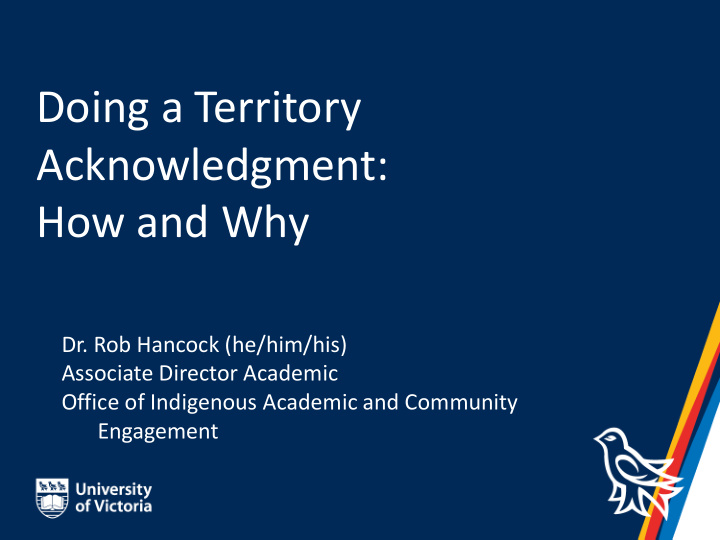



Doing a Territory Acknowledgment: How and Why Dr. Rob Hancock (he/him/his) Associate Director Academic Office of Indigenous Academic and Community Engagement
Territory Acknowledgment https://www.youtube.com/watch?v=Fwa9c8nqHUo (this version is close captioned, the embedded video in the presentation is not)
Territory acknowledgments Why do we do a territory acknowledgment? A territory acknowledgment is to be done at the beginning of meeting or gathering as a way to set the foundation for our time together. We go into our work with an open mind and an open heart, being mindful of the land that we are on, as we proceed with the rest of things that we need to do. It may be unfamiliar for you to do a territory acknowledgment at first, but it is important to put ourselves in a position that challenges and opens up our understanding of the peoples and history of this land as a part of our personal development and awareness. Learning and practicing the acknowledgment in advance will help you to become familiar with the words and connect with the importance of the acknowledgment.
Territory acknowledgments Why do we do a territory acknowledgment? 1. To honour the people and communities whose lands we’re on and to remind them that those groups still have relationships to the land today • In spite of colonialism, these are still the original caretakers of the land, and they have responsibilities to it as reflected through names, stories, etc. 2. To remind people to think about how they have come to be here • Including the impacts of colonialism 3. To foster a sense of responsibility to learn more about the people whose lands we live on, wherever we’re from 4. To offer an opportunity to think about what they will do differently knowing what they know now • The late Chief Andy Thomas, Esquimalt Nation, often asked how were going to walk differently on the land knowing that these nations have relationships with them, and responsibilities toward them
Territory acknowledgments Why do we acknowledge the territory in this way? The Office of Indigenous Academic & Community Engagement continues to work with the six local First Nations as part of the process of revising the University’s land acknowledgment to express most appropriately or respect for the peoples on whose land we work and study.
Territory acknowledgment The following acknowledgment was developed over 10 years in collaboration with local Indigenous Peoples: We acknowledge with respect the Lekwungen-speaking peoples on whose traditional territory the university stands and the Songhees, Esquimalt and WSÁNEĆ peoples whose historical relationships with the land continue to this day. To learn more about territory acknowledge at UVic, please follow this link: Indigenous Academic & Community Engagement, Territory acknowledgment
Pronounciation As with learning any new language, it’s important to practice how to pronounce words and names. One way that we recommend is to practice saying the acknowledgment and the titles of the nations and communities that we acknowledge while recording yourself via your phones/other devices and then listen back to yourself. Practice pronunciation: • Lekwungen (le-KWUNG-in) • Songhees (SONG-hees) • Esquimalt (es-KWAI-malt) • W SÁNEĆ ( wh-SAYN-itch)
Territory acknowledgment The Local Peoples: Lekwungen • Songhees • Esquimalt W SÁNEĆ (SENĆOŦEN): 1. Tsartlip 2. Tsawout 3. Pauquachin 4. Tseycum 5. Malahat
Territory acknowledgment Vancouver Island First Nations
Practice (10 minute breakout group) Working in small groups, you will have a chance to practice the university’s territory acknowledgment
Reflection (10 minute breakout group) After reading the background information about why we do a territory acknowledgment, what do you want to learn more about with regards to the history of the people and communities whose lands we’re on and how might you go about learning more? As the late Chief Andy Thomas, Esquimalt Nation, asked: how are you going walk differently on this land?
Thank you
Recommend
More recommend